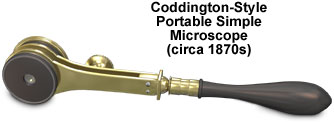Coddington-Style Portable Simple Microscope
Generally composed of brass, ebony, and glass, portable simple microscopes were popular with physicians, field botanists and in were often a centerpiece in the Victorian parlors of Europe and North America before the turn of the nineteenth century. The simple unsigned Coddington-style model illustrated below was redrawn from photographs of the original microscope, which was described by Gerard Turner in his book The Great Age of the Microscope.

Despite their simplicity, the resolution and imaging provided by these simple microscopes was often equivalent or even superior to pre-achromat compound microscopes that were haunted by spherical and chromatic aberrations. Specimens, often flower parts, or perhaps an insect (such as a flea), were held between two glass discs, one of which was fixed to the microscope, and the other to a push-on sample cell. A compressarium or live box was formed that could be adjusted to the size of the object. The Coddington lens, invented by Henry Coddington in 1829, is held in a complementary bracket to the compressarium. The single lens features two curved sides with a groove cut around the middle of the lens, which acts as a lens stop.
Focus of the microscope is adjusted by a large brass screw that pushes against the specimen bracket. A leather-covered wooden box (not illustrated), which is lined with silk and red velvet, holds the unsigned and undated simple microscope when it is in storage or transit. Circa 1870s, the handheld microscope resided in the extensive personal collection of Thomas Powell, until his death in 1925 and was eventually donated to the Royal Microscopical Society.
BACK TO NINETEENTH CENTURY MICROSCOPES
